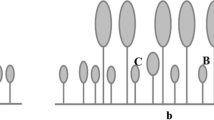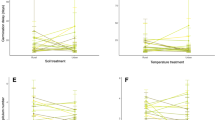Abstract
This paper addresses the phenotypic variation among Ricinus communis L. populations in four urban habitat types (road verges, garbage dumps, construction debris, and natural area) in Delhi, India, by evaluating important traits such as plant height, basal circumference, seeds per plant, seed size, seed weight, specific leaf area, and reproductive index. An important biochemical marker, proline, considered as a good plant performance indicator under stress was also quantified in leaves of R. communis to evaluate its response in different habitats. Interestingly, the species showed significant variation in plant height, specific leaf area, seed size, seed weight, and leaf proline content in different habitat types. Leaf proline content was positively related to plant height, specific leaf area, and seed size while negatively related to the total number of seeds/plant. Interestingly, reproductive index, calculated as a ratio of the total number of seeds to the plant height also showed a negative relation with leaf proline content. Results indicated that R. communis exhibits adaptive modulation of growth, reproductive traits, and leaf proline content in various urban habitats which contributes to invasiveness, range expansion, and establishment of the species. The study also gives evidence of how morphological and physiological traits could directly affect invasiveness of R. communis.

Similar content being viewed by others
References
Agrawal, A. A. (2001). Phenotypic plasticity in the interactions and evolution of species. Science, 294, 321–326.
Alba, C., & Hufbauer, R. A. (2012). Exploring the potential for climatic factors, herbivory, and co-occurring vegetation to shape performance in native and introduced populations of Verbascum thapsus. Biological Invasions, 14, 2505–2518.
Alia, & Pardha-Saradhi, P. (1993). Suppression in mitochondrial electron transport is the prime cause behind stress induced proline accumulation. Biochemical and Biophysical Research Communications, 193, 54–58.
Alia, Pardha-Saradhi, P., & Mohanty, P. (1997). Involvement of proline in protecting thylakoid membranes against free radical-induced photodamage. Journal of Photochemistry and Photobiology, B: Biology, 38, 253–257.
Anjani, K. (2012). Castor genetic resources: a primary gene pool for exploitation. Industrial Crops and Products, 35, 1–14.
Annapurna, C., & Singh, J. S. (2003). Phenotypic plasticity and plant invasiveness: case study of congress grass. Current Science, 85, 197–201.
Anonymous. (2006). Economic survey of Delhi. Planning Department, Government of National Capital Territory of Delhi (pp. 1–7): New Delhi
Aronson, J., Kigel, J., & Shmida, A. (1993). Reproductive allocation strategies in desert and Mediterranean populations of annual plants grown with and without water stress. Oecologia, 93, 336–342.
Baruch, Z., & Goldstein, G. (1999). Leaf construction cost, nutrient concentration, and net CO2 assimilation of native and invasive species in Hawaii. Oecologia, 121, 183–192.
Bates, L. S., Waldren, R. P., & Teare, I. D. (1973). Rapid determination of free proline for water stress studies. Plant and Soil, 39, 205–207.
Berg, M. P., & Ellers, J. (2010). Trait plasticity in species interactions: a driving force of community dynamics. Evolutionary Ecology, 24, 617–629.
Carter, S., & Smith, A. R. (1987). Euphorbiaceae flora of tropical East Africa. Rotterdam: A.A. Balkema.
Chun, Y. J., Collyer, M. L., Moloney, K. A., & Nason, J. D. (2007). Phenotypic plasticity of native vs. invasive purple loosestrife: a two-state multivariate approach. Ecology, 88, 1499–1512.
Colautti, R. I., & Barrett, S. C. H. (2013). Rapid adaptation to climate facilitates range expansion of an invasive plant. Science, 342, 364.
Cordell, S., Goldstein, G., Mueller-Dombois, D., Webb, D., & Vitousek, P. M. (1998). Physiological and morphological variation in Metrosideros polymorpha, a dominant Hawaiian tree species, along an altitudinal gradient: the role of phenotypic plasticity. Oecologia, 113, 188–196.
Daws, M. I., Hall, J., Flynn, S., & Pritchard, H. W. (2007). Do invasive species have bigger seeds? Evidence from intra- and inter-specific comparisons. South African Journal of Botany, 73, 138–143.
Grime, J. P. (1974). Vegetation classification by reference to strategies. Nature, 250, 26–31.
Hayat, S., Hayat, Q., Alyemeni, M. N., Wani, A. S., Pichtel, J., & Ahmad, A. (2012). Role of proline under changing environments. Plant Signaling & Behavior, 7, 1–11.
Hejda, M., Pyšek, P., Pergl, J., Sádlo, J., Chytrý, M., & Jarošík, V. (2009). Invasion success of alien plants: do habitats affinities in the native distribution range matter? Global Ecology and Biogeography, 18, 372–382.
Joshi, J., Schmid, B., Caldeira, M. C., Dimitrakopoulos, P. G., Good, J., Harris, R., Hector, A., Huss-Danell, K., Jumpponen, A., Minns, A., Mulder, C. P. H., Pereira, J. S., Prinz, A., Scherer-Lorenzen, M., Terry, A. C., Troumbis, A. Y., & Lawton, J. H. (2001). Local adaptation enhances performance of common plant species. Ecology Letters, 4, 536–544.
Kauffman, M. J., & Jules, E. S. (2006). Heterogeneity shapes invasion: host size and environment influence susceptibility to a nonnative pathogen. Ecological Applications, 16, 166–175.
Krishnan, A. (1977). A climatic analysis of the arid zone of north-western India. In Desertification and its Control (pp. 42–57). New Delhi: ICAR.
Lambers, H., & Poorter, H. (1992). Inherent variation in growth rate between higher plants: a search for physiological causes and ecological consequences. Advances in Ecological Research, 23, 188–261.
Lehmann, C., & Rebele, F. (2005). Phenotypic plasticity in Calamagrostis epigejos (Poaceae): response capacities of genotypes from different populations of contrasting habitats to a range of soil fertility. Acta Oecologica, 28, 127–140.
Lockwood, J. L., Cassey, P., & Blackburn, T. (2005). The role of propagule pressure in explaining species invasions. Trends in Ecology and Evolution, 20, 223–228.
MacNally, R. C. (1995). Ecological versatility and community ecology. Cambridge: Cambridge University Press.
Martins, V. F., Haddad, C. R. B., & Semir, J. (2011). Responses of the invasive Ricinus communis seedlings to competition and light. New Zealand Journal of Botany, 49, 263–279.
Mattioli, R., Costantino, P., & Trovato, M. (2009). Proline accumulation in plants: not only stress. Plant Signaling and Behavior, 4, 1016–1018.
Mitchell, C. E., & Power, A. G. (2003). Release of invasive plants from fungal and viral pathogens. Nature, 421, 625–627.
Moodley, D., Geerts, S., Rebelo, T., Richardson, D. M., & Wilson, J. R. U. (2014). Site-specific conditions influence plant naturalization: the case of alien Proteaceae in South Africa. Acta Oecologica, 59, 62–71.
Moshkin, V. A. (Ed.). (1986). Castor. New Delhi: Amerind Publishing Co. Pvt. Ltd
Novak, S. J., & Mack, R. N. (2005). Genetic bottlenecks in alien plant species: influence of mating systems and introduction dynamics. In D. F. Sax, S. D. Gaines, & J. J. Stachowicz (Eds.), Exotic species—bane to conservation and boon to understanding: ecology, evolution and biogeography (pp. 95–122). USA: Sinauer.
Pardha-Saradhi, P., Alia Arora, S., & Prasad, K. V. S. K. (1995). Proline accumulates in plants exposed to UV radiation and protects them against UV. Biochemical and Biophysical Research Communications, 209, 1–5.
Parker, J. D., Torchin, M. E., Hufbauer, R. A., Lemoine, N. P., Alba, C., Blumenthal, D. M., Bossdorf, O., Byers, J. E., Dunn, A. M., Heckman, R. W., Hejda, M., Jarošík, V., Kanarek, A. R., Martin, L. B., Perkins, S. E., Pyšek, P., Schierenbeck, K., Schlöder, C., van Klinken, R., Vaughn, K. J., Williams, W., & Wolfe, L. M. (2013). Do invasive species perform better in their new ranges? Ecology, 94, 985–994.
Pigliucci, M. (2005). Evolution of phenotypic plasticity: where are we going now? Trends in Ecology and Evolution, 20, 481–486.
Pyšek, P., & Richardson, D. M. (2007). Traits associated with invasiveness in alien plants: where do we stand? In W. Nentwig (Ed.), Biological invasions, ecological studies, 193 (pp. 97–126). Berlin & Heidelberg: Springer.
Pyšek, P., Jarošík, V., Hulme, P. E., Pergl, J., Hejda, M., Schaffner, U., & Vilà, M. (2012). A global assessment of invasive plant impacts on resident species, communities and ecosystems: the interaction of impact measures, invading species’ traits and environment. Global Change Biology, 18, 1725–1737.
Regehr, D. L., & Bazzaz, F. A. (1979). The population dynamics of Erigeron canadensis, a successional winter annual. Journal of Ecology, 67, 923–933.
Reich, P. B., Walters, M. B., & Ellsworth, D. S. (1997). From tropics to tundra: global convergence in plant functioning. Proceedings of National Academy of Science USA, 94, 13730–13734.
Rejmánek, M., & Richardson, D. M. (1996). What attributes make some plant species more invasive? Ecology, 77, 1655–1661.
Richards, C. L., Bossdorf, O., Muth, N. Z., Gurevitch, J., & Pigliucci, M. (2006). Jack of all trades, master of some? On the role of phenotypic plasticity in plant invasions. Ecology Letters, 9, 981–993.
Richardson, D. M., & Pyšek, P. (2006). Plant invasions—merging the concepts of species invasiveness and community invasibility. Progress in Physical Geography, 30, 409–431.
Scheiner, S. M. (1993). Genetics and evolution of phenotypic plasticity. Annual Review of Ecology and Systematics, 24, 35–68.
Schlichting, C. D. (1986). The evolution of phenotypic plasticity in plants. Annual Review of Ecology and Systematics, 17, 667–693.
Sexton, J. P., McKay, J. K., & Sala, A. (2002). Plasticity and genetic diversity may allow saltcedar to invade cold climates in North America. Ecological Applications, 12, 1652–1660.
Sharma, G. P., & Esler, K. J. (2008). Phenotypic plasticity among Echium plantagineum populations in different habitats of Western Cape, South Africa. South African Journal of Botany, 74, 746–749.
Sharma, G. P., & Raghubanshi, A. S. (2009). Plant invasions along roads: a case study from central highlands, India. Environmental Monitoring and Assessment, 157, 191–198.
Sharma, G. P., Raghubanshi, A. S., & Singh, J. S. (2005). Lantana invasion: an overview. Weed Biology and Management, 5, 157–165.
Simberloff, D., Martin, J. L., Genovesi, P., Maris, V., Wardle, D. A., Aronson, J., Courchamp, F., Galil, B., García-Berthou, E., Pascal, M., Pyšek, P., Sousa, R., Tabacchi, E., & Vilà, M. (2013). Impacts of biological invasions: what’s what and the way forward. Trends in Ecology and Evolution, 28, 58–66.
Skálová, H., Havlíčková, V., & Pyšek, P. (2012). Seedling traits, plasticity and local differentiation as strategies of invasive species of Impatiens in central Europe. Annals of Botany, 110, 1429–1438.
Song, L. Y., Ni, G. Y., Chen, B. M., & Peng, S. L. (2007). Energetic cost of leaf construction in the invasive weed Mikania micrantha H.B.K. and its co-occurring species: implications for invasiveness. Botanical Studies, 48, 331–338.
SPSS Inc. 2007. SPSS for Windows, Version 16.0 Release. Chicago, SPSS Inc.
Sultan, S. E. (2000). Phenotypic plasticity for plant development, function, and life-history. Trends in Plants Science, 5, 537–542.
Sultan, S. E. (2003). Phenotypic plasticity in plants: a case study in ecological development. Evolution and Development, 5, 25–33.
Todd, P. A. (2008). Morphological plasticity in scleractinian corals. Biological Reviews, 83, 315–337.
Torchin, M. E., Lafferty, K. D., & Kuris, A. M. (2001). Release from parasites as natural enemies: increased performance of a globally introduced marine crab. Biological Invasions, 3, 333–345.
van Kleunen, M., Weber, E., & Fischer, M. (2010). A meta-analysis of trait differences between invasive and non-invasive plant species. Ecology Letters, 13, 235–245.
Via, S., Gomulkievicz, R., de Jong, G., Scheiner, S. M., Schlichting, C. D., & van Tienderen, P. H. (1995). Adaptive phenotypic plasticity: consensus and controversy. Trends in Ecology and Evolution, 10, 212–217.
Yeh, P. J., & Price, T. D. (2004). Adaptive phenotypic plasticity and the successful colonization of a novel environment. American Naturalist, 164, 531–542.
Acknowledgments
We are grateful to the anonymous reviewers for their valuable comments on previous versions of this manuscript. NG acknowledges Junior Research Fellowship (JRF) support from University Grants Commission, New Delhi, India. PPS acknowledges University of Delhi for financial support. GPS acknowledges funding support from University of Delhi, India, as Seed and Research Grant and Department of Science and Technology, India.
Author information
Authors and Affiliations
Corresponding author
Rights and permissions
About this article
Cite this article
Goyal, N., Pardha-Saradhi, P. & Sharma, G.P. Can adaptive modulation of traits to urban environments facilitate Ricinus communis L. invasiveness?. Environ Monit Assess 186, 7941–7948 (2014). https://doi.org/10.1007/s10661-014-3978-0
Received:
Accepted:
Published:
Issue Date:
DOI: https://doi.org/10.1007/s10661-014-3978-0




